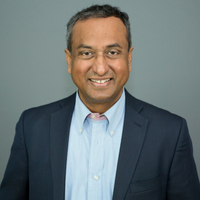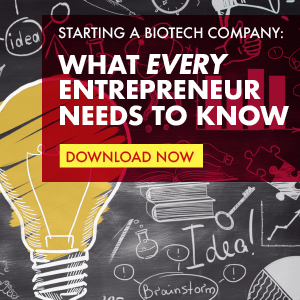
Partnering Insight recently had the pleasure of speaking with Dr. Chandra Ramanathan, Head of the East Coast Innovation Center at Bayer, whose mission is building an innovative product portfolio to address unmet need in patients by collaborating with key partners including academia and members of the local innovation ecosystem of biotech startups. Bayer is well known for its ability to leverage partnerships to foster innovation. Dr. Ramanathan will be participating on the panel “Working within your ecosystem: Leveraging the Boston biotech cluster” at BioPharm America™ taking place in Boston, MA, September 5–6. We spoke to Dr. Ramanathan to hear more about his work at the East Coast Innovation Center and his strategy for cultivating innovation.
The East Coast Innovation Center at Bayer is part of broader US innovation strategy that includes Bayer’s West Coast Innovation Center in San Francisco.
“Our strategy for identifying and working with the most innovative startups is based on three things,” said Ramanathan, described as:
- Advancing our pipeline through partnerships. Bayer is investing in key therapeutic areas and breakthrough technologies where we feel we have the most potential to improve patient health. Our partnership with the Broad Institute of MIT and Harvard is focused in the areas of oncology and cardiovascular diseases, and our partnership with Johns Hopkins University Wilmer Eye Institute aims to develop therapies for ophthalmology patients.
- Cultivating and advancing the Boston innovation ecosystem. Bayer is working closely with the startup entrepreneur community, patient research organizations and other innovators to develop better treatments for patients, faster. Bayer has mentored emerging life science entrepreneurs as an active member of MassBIO and served as a faculty mentor through the MIT-IMPACT program.
- Building upon on our external innovation strategy to explore solutions to complex challenges in the fields of health and nutrition. We’ve recently opened LifeHub Boston where, along with our Bayer colleagues from Crop Science and Consumer Health, we are collectively engaging with the Cambridge innovation community to explore, discover, test and co-create customer-focused solutions.
Identifying innovation
Ramanathan started his career in drug discovery, and moved along the value spectrum of discovery, development and commercialization. He came into his role at Bayer when he created a strategy that laid the foundation for the East Coast Innovation Center.
“Four years back, I headed up external innovation as part of innovation strategy; that job is not to look at current models, but rather to look at what the future holds and how to effectively engage with current and emerging partners to address patient needs,” said Ramanathan. “Perhaps even more important than looking for new partnerships is the role that Bayer has in the innovation ecosystem. I presume management gave me the job as Head of the Center based on that effort.”
When sifting for key identifiers, what does Ramanathan look for, i.e., what are those magic ingredients that make him stop and say, “This looks promising”?
“I think the first ingredient is a patient-centric mindset,” said Ramanathan.
“Drug development now requires a degree of specialization that a single organization can no longer achieve on its own,” said Ramanathan. “For me, it is critical that we have excellent clarity on our corporate strategy and laser focus on the unmet needs we are aiming to address, like oncology, cardiovascular, etc. With this clarity and focus, it becomes easy to make a match with a partner,” he said.
“Knowing what you want is highly effective because the partner enters the collaboration knowing exactly what Bayer is looking for, and what value all parties seek to gain from the partnership,” said Ramanathan.
From there, once an innovative idea appears to fit with Bayer’s portfolio, the next steps are designed to formalize the partnership while considering what type of collaboration will bring the most value.
“The first step is attained by being in the ecosystem and seeing the opportunity,” said Ramanathan. “Once the opportunity lines up with Bayer’s strategic priorities, we review it with key stakeholders in the company to see if it fits. Once this strategic alignment is clear, we look into collaboration.”
Bayer’s partnership with the Broad Institute in oncology is an example of this, where every decision is made jointly, resulting in bringing forward the best value of Bayer and of Broad. The parties were successful in jointly advancing an asset to the clinic in early 2018.
In other partnerships, the collaboration is a straight licensing agreement. “We bring the asset to Bayer and develop it internally,” said Ramanathan. “Or as with CRISPR Therapeutics, we formed a JV company with focus on certain disease areas.”
Pursuing strategic advantage
When looking for innovation, the benchmarks for early stage companies have changed. “What we define as ‘early’ has totally changed,” said Ramanathan. “In oncology, five years ago you would look for proof of concept (POC). Now, for POC you can look at early as filing with the FDA; therefore, you have to go much earlier with a preclinical signal or exciting science. And in certain technologies, like IO with all the checkpoint inhibitors, if a company has not gotten into the field by this time, they are blocked from getting into this space—it is too expensive or redundant. Determining early strategic advantage plays a major role in how we choose our partners,” said Ramanathan.
 “In the US, from Mission Bay on the west coast to Boston on the east coast, we interact with university researchers and find out what they are working on,” Ramanathan added. “If we find that their science is aligned with our strategic priorities, we develop an academic collaboration. We review a lot of academic publications, but that can be little bit too late.
“In the US, from Mission Bay on the west coast to Boston on the east coast, we interact with university researchers and find out what they are working on,” Ramanathan added. “If we find that their science is aligned with our strategic priorities, we develop an academic collaboration. We review a lot of academic publications, but that can be little bit too late.
“As part of this, we go to the various academic institutions. For example, Boston Brigham and Women’s Hospital and Massachusetts General Hospital both have academic seminar series where you can find out what is going on,” said Ramanathan. “There is not one single formula but a combination of different activities that lead to discovery.”
Ramanathan and Aaron Schwartz, Director, R&D Innovation Sourcing at Novo Nordisk Inc., will speak on the topic of what pharma companies, including Bayer, are looking for at BioPharm America™ in September.
“I am definitely looking forward to the panel at BioPharm America™,” said Ramanathan. “I believe early life science integration is an opportunity for pharma going forward.”
Focus on the future
In addition, Ramanathan listed several major burdens we will face in the future that invite opportunities for innovation.
“Our planet cannot support a population of 10 billion by 2050. It will present grave deficiencies in food production and agriculture. This is not a topic for BioPharm America, but it is important to think about the future in terms of technologies to support crop sustainability,” said Ramanathan.
“The growing and aging population will play a role as well,” said Ramanathan. “In modern times, we have pushed back this transition from wellness to illness to the later part of our lives. For Bayer, a hot topic is our position in consumer health related to this transition from a state of wellness to illness.
“Along these lines, another hot topic will be what digital technologies we can introduce and integrate into human healthcare to mitigate future illness burdens,” said Ramanathan.
Ultimately, the message to biotech startup companies is to focus on the “why” in what they are doing, in terms of the future benefit to patients.
“Since moving to Boston, I have been deeply engaged with the biotech startup community,” said Ramanathan. “My advice to biotech startups is to keep their end goal of addressing unmet medical need for patients in mind. I would also advise startups to talk with pharma partners regarding translation. If you are working with unique value for patients, that will drive you, and you will make all the right decisions.”
At the end of the day, this interaction with people on the verge of discovery is at the core of what drives his work.
“I started my career in genomics 21 years back,” said Ramanathan. “Since then, the technology has matured, and creating value for patients is the renewed priority. Being part of the biotech startup ecosystem, and the potential transformation we can provide for patients and human health, that excites me.”
The Bayer licensing and business development team will on site at BioPharm America™, and Ramanathan advises companies that are interested to reach out and request to meet with him through partneringONE®. “If I am not the right person, I will forward your inquiry to the right people at Bayer,” said Ramanathan.

